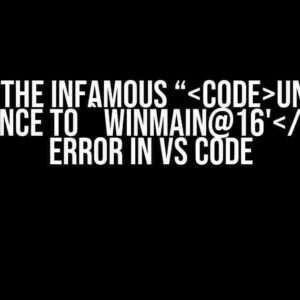As a C++ enthusiast, you’ve likely stumbled upon the wonderful world of alias templates. These powerful tools allow you to create concise and expressive type aliases, making your code more readable and maintainable. But, as you delve deeper into the realm of alias templates, you may wonder: are constrained alias templates allowed? In this article, we’ll embark on a journey to explore the ins and outs of constrained alias templates, providing you with a comprehensive understanding of this fascinating topic.
The Basics of Alias Templates
Before we dive into the world of constrained alias templates, let’s review the fundamentals of alias templates in general. An alias template is a type alias that can be parameterized using template parameters. This allows you to create a family of related types that can be used in a variety of contexts. Here’s a simple example:
template <typename T>
using MyType = std::vector<T>;
In this example, we’ve defined an alias template called `MyType` that takes a single template parameter `T`. This allows us to create a family of `std::vector` types, each with a different type parameter. For instance, we could use `MyType
Constrained Alias Templates: A Brief Introduction
With the basics of alias templates under our belt, let’s move on to the concept of constrained alias templates. A constrained alias template is an alias template that uses a concept or a requires clause to restrict the types that can be used as template parameters. This allows you to create more expressive and flexible type aliases that can adapt to different contexts. Here’s an example:
template <typename T>
requires std::copyable<T>
using MyType = std::vector<T>;
In this example, we’ve added a requires clause to our alias template, constraining the type parameter `T` to be copyable. This ensures that only types that satisfy the `std::copyable` concept can be used as template parameters. For instance, we could use `MyType
Benefits of Constrained Alias Templates
So, why should you care about constrained alias templates? Here are a few compelling reasons:
- Better Code Safety**: By constraining the types that can be used as template parameters, you can prevent errors and ensure that your code is safer and more reliable.
- Improved Code Readability**: Constrained alias templates can help to clarify the intent of your code, making it easier for others to understand and maintain.
- Enhanced Flexibility**: With constrained alias templates, you can create more flexible and adaptable code that can be used in a variety of contexts.
How to Use Constrained Alias Templates
Now that we’vecovered the benefits of constrained alias templates, let’s dive deeper into how to use them in practice. Here are some tips and best practices to keep in mind:
- Choose the Right Concept**: When defining a constrained alias template, it’s essential to choose the right concept or requires clause to constrain the type parameter. This ensures that only the intended types can be used as template parameters.
- Keep it Simple**: While it’s tempting to create complex and elaborate constraints, it’s essential to keep things simple and concise. This makes your code easier to understand and maintain.
- Use Constrained Alias Templates Judiciously**: Constrained alias templates should be used judiciously, as they can add complexity to your code. Use them only when necessary, and prefer unconstrained alias templates when possible.
Here’s an example of how you might use a constrained alias template to create a type alias for a vector of copyable types:
template <typename T>
requires std::copyable<T>
using CopyableVector = std::vector<T>;
In this example, we’ve defined a constrained alias template called `CopyableVector` that takes a single template parameter `T`. The requires clause ensures that only copyable types can be used as template parameters, making it safer and more reliable.
Common Pitfalls and Errors
As with any powerful tool, constrained alias templates can be misused or misunderstood. Here are some common pitfalls and errors to watch out for:
| Pitfall/Error | Description |
|---|---|
| Over-Constraining | Defining constraints that are too restrictive, limiting the usability of the alias template. |
| Under-Constraining | Defining constraints that are too permissive, allowing unintended types to be used as template parameters. |
| Misusing Concepts | Using concepts or requires clauses that are not well-defined or are misused, leading to errors or unexpected behavior. |
By being aware of these potential pitfalls and errors, you can avoid common mistakes and ensure that your constrained alias templates are safe, reliable, and effective.
Best Practices and Recommendations
To get the most out of constrained alias templates, here are some best practices and recommendations to keep in mind:
- Use Clear and Concise Names**: Choose names that accurately reflect the intent and constraints of your alias template.
- Document Your Constraints**: Clearly document the constraints and requirements of your alias template, making it easier for others to understand and use.
- Test Your Constraints**: Thoroughly test your constrained alias templates to ensure they work as intended and catch any errors or unexpected behavior.
By following these best practices and recommendations, you can create effective and reliable constrained alias templates that enhance the readability, safety, and maintainability of your code.
Conclusion
In conclusion, constrained alias templates are a powerful tool in the C++ programmer’s arsenal. By understanding how to use them effectively, you can create more expressive, flexible, and reliable code that adapts to different contexts. Remember to choose the right concept, keep it simple, and use constrained alias templates judiciously. With practice and experience, you’ll become a master of constrained alias templates, unlocking the full potential of C++ programming.
So, are constrained alias templates allowed? Absolutely! With the right approach and best practices, you can harness the power of constrained alias templates to take your C++ programming to the next level.
Happy coding!
Frequently Asked Question
Unravel the mysteries of constrained alias templates and get the inside scoop on what’s allowed and what’s not!
Can I use constrained alias templates in C++?
In C++20 and later, constrained alias templates are a game-changer! Yes, you can use them to create type aliases that depend on template parameters, making your code more expressive and flexible.
Are there any limitations to constrained alias templates?
While constrained alias templates offer a lot of power, there are some restrictions to keep in mind. For example, you can’t use them to create aliases for non-type template parameters, and you can’t use them recursively. But don’t worry, these limitations are in place to prevent confusing or ambiguous code!
Can I use constrained alias templates with SFINAE?
SFINAE (Substitution Failure Is Not An Error) and constrained alias templates are a match made in heaven! You can use SFINAE to create more expressive and flexible alias templates that can be used in a variety of contexts.
Do constrained alias templates work with concepts?
Concepts and constrained alias templates are closely related! In fact, constrained alias templates are a key feature of C++20’s concept TS (Technical Specification), which makes it easier to define and use concepts in your code.
What are some real-world use cases for constrained alias templates?
Constrained alias templates can be used in a variety of real-world scenarios, such as creating type-safe APIs, implementing generic algorithms, and even building Domain-Specific Languages (DSLs)!




